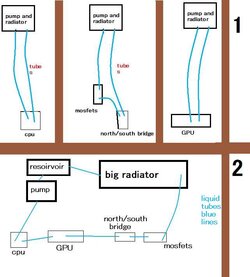- Joined
- Mar 24, 2010
Go look at my picture.
http://www.overclockers.com/forums/attachment.php?attachmentid=81706&stc=1&d=1270276705
Which is better to do?
I mean look at section 2 in my picture, by the time water gets to the mosfets wont it be REALLY hot? Hot because that water already went through the CPU, GPU, north and south bridge.
OR
Is it better to break it up with smaller pumps and smaller radiators, like I show in section 1 in my picture. This means the CPU gets its own small pump/radiator/reservoir. The GPU gets its own small pump/radiator/reservoir. And the mosfets, north and south bridge share one small pump/radiator/reservoir.
Which setup gets me cooler results for all these computer parts?
YES, I know I'm not doing more than 2 video cards, but I'm poor. Sorry. I'll get the second one later, maybe.
http://www.overclockers.com/forums/attachment.php?attachmentid=81706&stc=1&d=1270276705
Which is better to do?
I mean look at section 2 in my picture, by the time water gets to the mosfets wont it be REALLY hot? Hot because that water already went through the CPU, GPU, north and south bridge.
OR
Is it better to break it up with smaller pumps and smaller radiators, like I show in section 1 in my picture. This means the CPU gets its own small pump/radiator/reservoir. The GPU gets its own small pump/radiator/reservoir. And the mosfets, north and south bridge share one small pump/radiator/reservoir.
Which setup gets me cooler results for all these computer parts?

YES, I know I'm not doing more than 2 video cards, but I'm poor. Sorry. I'll get the second one later, maybe.


 to OCF!
to OCF!